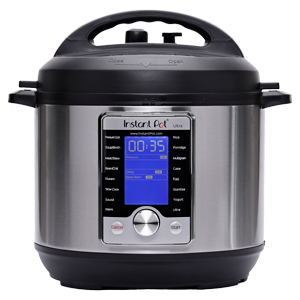Dry beans cook up quickly into a healthful, inexpensive meals in electric pressure cookers.
October 22, 2018 - Author: Theresa Reynolds, Author: Shannon Klisch, Author: Dayna Ravalin , Author: Katherine E Soule - You may have heard the buzz about electric pressure cookers. Even if you don't follow kitchen trends, this piece of equipment may take some of the "pressure off" of preparing meals. From personal experience, I can say that they're also quite fun! A typical electric pressure cooker. Credit: Instant Pot
A typical electric pressure cooker. Credit: Instant Pot
Pressure cooking vs. pressure canning
Pressure cooking uses trapped steam to create a pressurized environment for cooking food. This combined with heat can greatly decrease cooking times for many items. Foods like dried beans, meat roasts and rice can have a significantly shorter cooking time when they are pressure cooked. Some people may recognize the term pressure canning which uses pressure to preserve foods. While they are similar in the process, only equipment specifically labeled for pressure canning can be used safely for food preservation.
Why so popular?
Pressure cookers existed first as a stove top version that required manual monitoring of pressure. Electric pressure cookers arose to help streamline and simplify the process. They have digital settings and controls so are generally easy to use. The quick cooking time and ability to electronically set time and temperature also increase their consumer appeal. In addition, the cooker is a closed system which helps retain moisture, nutrients and flavor. Unfortunately, there is not a lot of scientific research on nutrient retention in pressure cooking. One study did find that pressure cooking retained more vitamin C in broccoli than compared to boiling or steaming.
Additionally, electric pressure cookers are more energy efficient than stove top or oven cooking. They are insulated which prevents energy from being lost in the cooking process.
Becky Hutchings, a family and consumer sciences educator for University of Idaho Extension, currently offers a very popular introduction to electric pressure cookers class in her community. She feels electric pressure cookers can help people save money and time with cooking. Hutchings has said, “I think with pressure cookers, people are scared that it's going to blow up. Once they use their electric pressure cooker they will realize how easy and fast it is. They wonder how they ever lived without it.”
Safety concerns
As with any piece of equipment, there are safety concerns. Some models are considered “multi cookers” and may have a setting for slow cooking. This may be misleading as the slow cooker setting will not pressure cook. You cannot leave food in the cooker to be pressure cooked later because it will be in unsafe temperatures and will increase the risk for foodborne illness. For example, if you are planning to cook a pork roast in the electric pressure cooker, you cannot prepare it in the morning and leave it out on the counter until the evening. You will have to keep the food refrigerated until it is ready to be cooked.
Additionally, standard food safety practices should still be followed. Even if a roast looks done, check that temperature! Electric pressure cookers can be easily reset to cook for additional time if needed.
A third and significant concern is canning with electric pressure cookers. UC Cooperative Extension takes education on food preservation very seriously. We only support research-based and tested recipes for preservation. Many brands of electric pressure cookers provide recipes for canning. However, NONE of the brands have been able to supply their research or information supporting these recipes
The National Center for Home Food Preservation has a great article explaining why this is a concern. In short, electric pressure cookers have not been studied to ensure the necessary requirements for safe canning. Therefore, UC Cooperative Extension does NOT support or encourage canning in electric pressure cookers.
Hutchings explains it quite simply as “You are putting your life at risk."
(Pressure canning is a whole other wonderful field of cooking and preservation. We have many resources and articles available to learn more about it.)
While some models may be more “instantly” recognizable than others, there are many brands available for purchase. Just because a brand has popularity may not mean it is right for you. There are many online resources providing reviews and recipes for all the main brands of electric pressure cookers available. Prices of models range from $50 to $100. They are a more expensive piece of equipment, but savings could be seen in reduced cooking time and energy efficiency. In addition, there is a lot of money saved when cooking at home when compared to ordering delivery or eating at restaurants. An electric pressure cooker may be tool you need to making cooking at home easy and accessible.
If you are a new electric pressure cooker owner looking for support, Hutchings has a Facebook support group: Cooking Under Pressure - An Electric Pressure Cooking Community. She shares recipes, resources and occasionally hosts Facebook Live lessons.
Resources:
- https://www.uidaho.edu/extension/news/story/cooking-pressure
- https://blogs.extension.iastate.edu/answerline/2016/11/21/electric-pressure-cookers/
- https://extension.usu.edu/foodsense/cook/pressure-cooking
- https://nchfp.uga.edu/publications/nchfp/factsheets/electric_cookers.html
Source: UCANR








